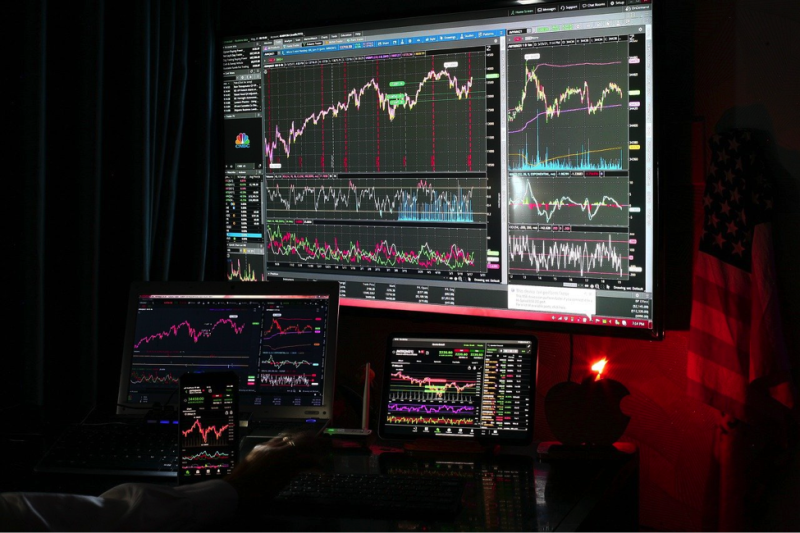
Option Greeks are financial instruments for estimating the reactivity of an option’s price to its elemental parameters, like the volatility or the asset's price.
The Greeks get implemented for the examination of an options portfolio. But also the research on the option’s sensitivity. Most investors see the measures, as crucial for formulating an investment strategy in options trading.

The key option Greeks are Gamma, Delta, Vega, Rho, and Theta. But traders must remember that the list doesn't end with the previously mentioned Greeks, and alternative option Greeks that developed from the primary Greeks.
The choice of name maybe was not wise, and for the uninitiated when they hear traders are implementing the Greeks, there is confusion about who these Greeks are and more crucially what they do.
In a more simplified attempt to describe the Greeks, they can get perceived as a calculation that gets used to estimating various factors that can influence the option's contract price.
There is no understating the fact that investors depend on the information, and the Greeks are one of the methods to get a feel for the pulse of the marker and implement informed decisions.
The Greeks are named for letters of the Greek alphabet, and a short introduction is in order before we start our breakdown of the concepts.
The Greeks include:
- Delta gets used for assessing the possibility for an option to expire in-the-money (ITM), signaling the strike price is under or over elemental security’s market price.
- Theta calculates by how much an option's worth will decline in a day as it nears expiration.
- Gamma focuses on Delta and ascertaining the level of change in that parameter in case the price of stock changes.
- Vega help assess the price swings in the given asset by considering the option's sensitivity.
- Rho makes it possible to replicate the influence of fluctuations of interest rate changes on options.
Let's take a more serious analysis and discover how Greeks can get implanted in a trading strategy.
Also Read: Everything About The Gamma Squeeze
Contents
- What Are Options Contracts
- Profitability
- Volatility
- Delta
- Gamma
- Theta
- Vega
- Rho
- How do Greeks Enable the Understand of Options?
- Implied Volatility Greek Style
- Minor Greeks
- Conclusion
- FAQs
What Are Options Contracts
When traders want to hedge a portfolio they turn to options contracts . This is done to balance potential adverse effects in other investments. They are practical for guessing if the price of an asset will decline or rise.
Basically, a call option offers the option holder the opportunity to purchase the elemental asset, but a put option enables the trader to sell the given asset.
Options can get exercised in other words, it's possible to get transformed into shares of a given asset at a stated price named the strike price. Each option comes with an expiration date, and the expense and worth connected with it are called the premium.
The price premium of an option gets based on a pricing model for the option, and this can result in fluctuations of the underlying asset price. Greeks are typically examined in combination with the option price model that enables the estimation of the possible risk.
Profitability
Several terms characterize if the option will generate profits or not. When investors contrast the strike price with the particular price of an asset or stock, when the variation produces profit, that sum gets named the intrinsic value.
The at-the-money option indicates that the strike price of the option and the underlying asset's price is identical. An in-the-money option signals that there is potential for profit because of the strike price of the option being more supportive of the given price.
The opposite is the case with out-of-the-money (OTM) options that signal there is no potential for profit if you contrast the strike price of the option and the particular price.
An out-of-the-money call option reveals that the elemental price is smaller than the strike price. Alternatively, with a put option as the OTM, the underlying price will be bigger than the strike price.
Volatility
Investors always focus on the volatility and for good measure, it indicated the degree by which the option's premium and the value of the market value experience variations up to its expiration.
The price variations can result from different factors, which can be an amalgamation of economic conditions, geopolitical events, and the company's performance, but also the general market.
Implied volatility indicates the perspective of the market and the option for a price to alter. Traders implement implied volatility, to predict upcoming moves in the stock and the price of the option's price.
The options premium is probably going to rise when implied volatility increases.
Delta
Delta estimates the upcoming movement of an option’s price for every $1 adjustment in the price of the given index.
For example, a Delta of 0.50 signals the price of the option can move $0.50 for every $1 adjustment in the price of the given stock. What this reveals is that the larger the Delta, the greater the price change.
Investors frequently implement Delta to forecast if a particular is going to expire ITM. What this means is that a Delta of 0.40 signals that during that period the option faces a 50% chance of making the ITM at expiration.
However, it should not be understood that a larger Delta will be more profitable. When you pay a bigger premium for an option that will expire at ITM, in that case, the trader may not make a profit.
Investors can perceive Delta as the quantity of shares of the elemental stock the option imitates. Finally, a Delta of 0.50 proposes a one-dollar move in the basic stock, the option will probably appreciate or decline by the identical quantity of money as 50 shares of the stock.
Call options:
- Typically at-the-money options possess Delta close to 0.50.
- The positive Delta for call options ranges between 0.00 to 1.00.
- The Delta will rise as the option nears the ITM.
- As expiration nears, out-of-the-money call options the Delta will get closer to 0.00.
- The ITM call options Delta nears to 1.00 with the approach of the expiration.
Put options:
- The Delta declines as the option nears the ITM.
- The negative Delta of put options is between 0.00 to –1.00.
- With the approach of expiration, the Delta of ITM put options will be near –1.00.
- The Delta of at-the-money options typically is close to –0.50.
- The out-of-the-money put options Delta will be near to 0.00 with the approach of expiration.
Gamma
With Delta, investors get a glimpse in a moment in time, while Gamma estimates the degree of change in an option’s Delta over time. You can picture these two as speed for Delta and acceleration for Gamma.
Gamma measures the pace of adjustment in an option’s Delta per one dollar in the basic stock price.
In our previous Delta example, we pictured a Delta option of .50. When the basic moves one dollar the option moves $.50 in parallel and the option’s Delta will not be 0.50.
The reason for this is that one dollar move signals the call option is going deeper ITM, and the Delta will be near to 1.00. Let's consider that the effect of Delta is 0.65. The adjustment in Delta from 0.50 to 0.65 is 0.15— and it represents the option’s Gamma.
Because Delta is not able to go over 1.00, Gamma declines as an option to move away from ITM and Delta closes on 1.00. Logically the acceleration stops if speed is no longer part of the equation.
Theta
Theta indicates the percentage of an option's price will decline every day as the option closes to the expiry date when every other element stays identical. Time decay is the term used to describe this form of erosion in the price of the underlying asset.
But it's not a linear process, the connotation is that the erosion in price of at-the-money (ATM), just marginally out-of-the-money, and ITM options typically rise as the expiration nears, but that of far out-of-the-money (OOTM) options will decline with the approach of expiration approaches.
Vega
Vega estimates the pace of adjustment in an option’s price per one-percentage-point change in the implied volatility of the basic stock.
If you haven't noticed Vega is not part of the Greek alphabet, the purpose is to inform traders by what degree the option’s price will move in response to the volatility of the basic index rise or decrease.
Volatility is a crucial element that influences the value of the option. A decline in Vega will usually result in the depreciation of calls and puts. But a rise of Vega will have the contra effect for both puts and calls.
Ignoring Vega can result in overpay when purchasing options. When all factors are identical plan on purposing options when Vega is under the standard levels and selling options if Vega is over the standard levels. This can get discerned by analyzing implied and historical volatility.
Rho
Rho calculates the upcoming adjustment in an option’s price per one-percentage-point change in interest rates. It's practical for discovering the degree to which the price of an option will rise or decline if the risk-free interest rate rises and declines.
Let's take a hypothetical asset that’s trading precisely at its strike price. When the stock trades $15, the 215 calls and the 21 puts are going to be precisely at the money. If you spot the calls being traded for, $0.70, and the puts are transacted for $0.60.
If the interest rates are in the low range, the price variation between puts and calls will be insignificant. When interest rates rise the gap will get bigger and the cost of calls will climb but puts will get cheaper.
Rho is usually not a big factor in the price of an option, although it can get examined if the dominant interest rates change.
How do Greeks Enable the Understand of Options?
The Greeks are useful instruments for options traders that can use them to measure the risk that comes with various options. Traders implement them for formulation decisions about investments and pinpoint risk for the present portfolio. The biggest advantage of the Greeks for trades is the fact they offer data that help steer the course of future investments.
The options price is decided with the pricing model, which considers various factors, like price options and volatility.
It’s crucial to know that the Greeks are founded on mathematical formulas. Because of the complex equations that are necessary to determine the Greeks and how crucial is the data to be precise, the software is readily used to estimate the Greeks.
Most brokerage firms typically implement the setup and use those formulas, so you can get in touch with your broker and source the values from them. The fact that the Greeks can get implemented in assessing the opportune future prices, no guarantee exists they will stay reliable.
The biggest advantage of the Greeks is that they eliminate the need for making assumptions for options trading. Novice investors can encounter difficulties in trading with an option if they lack experience.
It is crucial to understand that Greeks don't function solo they are frequently changing. An alteration in a single Greek can influence other Greeks. But Greeks are one a single tool that can get implemented to deduce the risk traders are exposed to when making large investing decisions.
Implied Volatility Greek Style
Implied volatility is not actually a Greek but it's closely related. It predicts the level of volatility of an underlying stock in the future, however, it's mostly theoretical.
Although there is an option to predict the moves in the future by observing the historical volatility, it also shows the price of an option is an interpretation created from several factors, such as reports about quarterly and yearly earnings and announcements of product launches.
When the implied volatilities are larger than what is standard, they tend to be more profitable for sellers of options, and volatilities that are smaller than the usual work in the buyer's favor, this is because volatility changes back to the average over time.
Deciding the level of stock volatile at any period is hard, that's why examining implied volatility can offer insight about assumptions that are used by market makers for selecting the ask and bid prices. Because of this implied volatility is a practical resource in estimating the market.
Typically implied volatility is not dependable for every option of a given index and will usually be smaller for at-the-money and near-the-money options.
Options trading platforms generally offer implied volatility, and the reason is it's more practical for traders to know the volatility of the market and how that influences a given stock, instead of trying to do it by themselves.
Minor Greeks
Apart from the main Greek risk factors we analyzed previously, options traders can examine other, more distinctive risk factors. For example rho, that indicates the pace of change among option's value and the one percent adjustment in the interest rates. This estimates the subtlety to interest rates.
Consider a call option with a rho of 0.06 and a price of $1.30. In case the interest rates climb by one percent the call option value will rise to $1.35, all else staying the same. The alternative is the case for put options where rho is bigger for at-the-money options with a long period to expiry.
Few of the other minor Greeks include epsilon, vomma, lambda, vera, zomma, speed, and ultima.
The second and in some cases third-derivatives of the pricing model are the minor Greeks that get influenced by factors like alterations in delta and a volatility adjustment.
They are frequently used in options trading strategies because software can process them faster and take incorporate complicated risk factors.
Conclusion
The Greeks offer crucial calculations of the risks in an option position and potential benefits. Investors must learn the basic elements, before progressing to using them in their strategy. But discerning the capital that is at risk with an options position is not sufficient.
Traders must understand how to identify the different risk-exposure estimations, so they can get a picture of the chance a trade produces profits at the specified price.
Because conditions are frequently altering, the Greeks offer investors the tools to figure out the sensitivity of a given trade to fluctuations in price and volatility over time.
By taking a combined approach of learning the Greeks, investors get a reliable perspective that can improve their options trading.
FAQs
Can Greeks be Used to Understand Combination Trades
The Greeks are not only practical for individual options, they can get implemented for positions that combine several options. By doing this traders can quantify different risks of the trades you are thing about, and it makes no difference the level of complexity.
Why Is Vega Important?
Vega has an important role in identifying the potential for the risk-reward potential of an options trade. When investors think that the option's value is not realistic, they can implement Vega to choose an options strategy with the biggest potential for earnings.
What Is Rho and How Is It Used?
Rho estimates the sensitivity of an option contract’s concerning the interest rate changes and is shown as the forecaster alteration in the value of the option as a percentage point adjustment in interest rates.

















